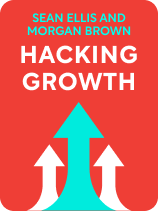

This article is an excerpt from the Shortform book guide to "Hacking Growth" by Sean Ellis and Morgan Brown. Shortform has the world's best summaries and analyses of books you should be reading.
Like this article? Sign up for a free trial here.
What is Sean Ellis and Morgan Brown’s Hacking Growth about? What is the key message to take away from the book?
In Hacking Growth, Sean Ellis and Morgan Brown present a non-traditional method for driving your business’s growth. Their method has helped top tech companies go from small startups to billion-dollar giants. Dubbed “growth hacking,” it entails focused and rapid experimentation to continually optimize your business for growth.
Below is a brief overview of Hacking Growth by Sean Ellis and Morgan Brown.
Hacking Growth: How Today’s Fastest-Growing Companies Drive Breakout Success
In today’s fast-paced, high-tech world, old approaches to marketing no longer work. Large-scale, big-budget advertising campaigns are too slow and imprecise for the online world. Better by far is to use growth hacking, the authors’ cutting-edge strategy for optimizing your business and skyrocketing its growth.
In Hacking Growth, Sean Ellis and Morgan Brown present a non-traditional approach to refining your marketing, product design, user experience, and more. Ellis and Brown were two of the first Silicon Valley pioneers to devise growth hacking strategies, and their methods have been used by top tech companies as well as startups to create massive growth.
Our guide covers the authors’ method in three parts, from preparation through to execution. Note that the authors’ strategies apply primarily to online businesses, whether ecommerce, software-as-a-service, retail, or other online companies.
- Part 1: Setting up: We’ll explain how to make sure your product is “must-have,” how to build your growth team, and how to set up your data analytics.
- Part 2: The growth hacking cycle: We’ll cover the core method of growth hacking, as well as how to run meetings and keep your team focused on the right objectives.
- Part 3: Customer development: We’ll detail the key strategies and tactics for four phases of growth: Getting customers to sign up, stick around, spend money, and stay loyal.
In addition, we’ll discuss strategies that complement or supplement the authors’, note possible ethical issues with some data-driven business practices, and discuss contemporary resources (free and paid) that you can use to up your growth hacking game.
Part 1: Setting Up Your Growth Hacking Basics
In this section, we’ll explain what you need to have in place before you can start driving your company’s growth. This includes ensuring you’ve got a product customers can’t go without, building your growth team, and setting up your data analytics. With these preparatory steps taken care of, you’ll have a solid foundation on which to grow—however, keep in mind that building a great product isn’t enough to attract and keep customers. Even with a great product, you’ll still have to work hard and be creative to attract customers and grow your business.
Step 1: Ensure Customers Can’t Go Without Your Product
Before you start growth hacking, the authors recommend making sure your business offers a product or service that customers won’t want to miss out on. It should deliver so well on a target market’s needs that people would be unhappy if they lost it. Your product or service should also deliver a “click” moment—an experience where customers suddenly see how the product is indispensable to them (the authors call this an “aha” moment). For instance, a cloud-based writing platform might “click” for a remotely distributed writing team when they see how it lets them collaborate without time or location constraints.
According to the authors, you can determine whether your product is indispensable by running a simple survey. In short, they recommend that you ask your users how they would feel if they could no longer use your product. Offer the following multiple choice answers: Very disappointed, disappointed, neutral, not bothered. If at least 40% of your users would be very disappointed, your product is indispensable.
To determine your “click” moment, use these two tactics:
- Tactic #1: Reach out to the 40% of loyal users who’d be very disappointed to lose your product or service and ask them about their favorite features. This tells you what people already love about your product.
- Tactic #2: If you already have user data, look for patterns in the behavior of your users. Find the overlaps in how they use the product to identify your most valuable features.
If you don’t have that 40% of loyal users or an obvious click moment, the authors recommend improving your product before you do growth hacking. Start by asking the users who wouldn’t mind losing your product about the alternatives. What would they use instead? Then, research those competitors’ products and use that information to improve your own.
(Shortform note: Finding the “click” moment has become a common tactic in startup culture, particularly with software-as-a-service (SaaS) companies using the agile, evidence-based strategies advocated by the authors. Some call that moment an “emotional reaction” you have when seeing the true value of a product—for instance, you might’ve thought aha when you saw how cloud storage allows you to sync your work across multiple devices. Another way to find these is to conduct new user interviews and listen for any positive emotion in how they describe using your product.)
Don’t be afraid to pivot if your click moment isn’t what you expected. The authors say that many major companies began with products that they changed to better deliver on the customer’s favorite features. For example, the messaging app Slack came about after parent company Tiny Speck failed to launch an online video game, and they instead pivoted to selling the messaging tool they had built to communicate between offices about the game.
(Shortform note: While pivoting is common, some companies recommend staying the course with your original ideas. One big example is Pinterest: Founder Ben Silbermann explains that many of the features you’ll see on Pinterest today were part of their original design. While the company grew slowly and looked to be struggling early on, they stuck to their vision and gradually built a community of dedicated users around a product they loved.)
Step 2: Build Your Growth Team
Now that you have your must-have product, it’s time to build your growth team. Here, we’ll look at the key roles you need on your growth team, as well as how to determine your team’s focus and your key growth metrics.
According to the authors, you need a dedicated growth team whose sole purpose is to find and capitalize on your business’s opportunities to grow. This is because the modern business environment is increasingly competitive, fast-paced, and prone to disruption. As such, you can’t afford to treat growth as a side project—instead, treat it as central to your success.
Growth Teams Are Interdisciplinary
The authors say that growth hacking can involve changing various aspects of your business, from marketing and sales to product development and software engineering. Given this, a growth team must be interdisciplinary and involve members from multiple departments of your business. At minimum, the team should include the following roles:
- The growth lead: This is the team leader who runs meetings, keeps people focused, and reports to higher ups about the team’s work.
- The analyst: To drive growth with data-based insights, someone who’s well-versed in data analysis should participate. She’ll work with the growth lead to generate key insights.
- The product manager: This person keeps your growth efforts in-step with your product, and provides perspectives on branding and product development.
- The marketer: Your marketer brings expertise in consumer psychology, copywriting, brand messaging, and more. All of this helps you find and exploit growth opportunities.
- The engineer: In an increasingly online world, you need skilled software engineers. An engineer will speak to the technical side of your proposed hacks and code them.
Each of these roles brings unique skills and perspectives to the table. According to the authors, putting them together increases creativity, innovation, and your team’s ability to deliver an exceptional user experience from top to bottom.
Step 3: Set Up Your Data and Analytics
With your growth team set up, the next step is to equip them with proper data instrumentation. The authors say that data analysis is key to growth hacking; without it, you’ll be taking shots in the dark. For example, you’ll want to know which features users prefer, how users found your business, what percentages of users sign up, and so on.
According to the authors, today’s customers have no shortage of competitive options. Given this, no business can afford to be imprecise or unscientific about where they invest their limited resources. Traditional, big-budget advertising pushes are no longer the way—they’re simply too slow and cumbersome for the modern market. Further, companies often make the mistake of running advertising campaigns without rigorous, empirical support for the ideas.
(Shortform note: While data-driven business strategies are more effective and cost-efficient than ever, note that many of the companies that perfected these strategies—Facebook, Amazon, Google—have come under fire for using “Big Data” to reach too far into people’s lives. In The Age of Surveillance Capitalism, Shoshana Zuboff argues that major tech companies gather large amounts of user data in order to predict user behaviors, sell advertising spaces, and even influence the decisions users make. While the authors of Hacking Growth don’t advocate for this, they do praise the mindset and method of Silicon Valley, which gave rise to the phenomena Zuboff describes.)
In contrast, the authors explain that growth hacking focuses on small, data-driven changes:
- Small changes allow you to iterate rapidly, pivot with ease, and avoid wasting resources on things that don’t work out.
- Data and analytics allow you to find a rationale for everything you do, so that you’re making educated guesses instead of taking shots in the dark.
(Shortform note: This rational approach to business growth—formulate hypotheses, test them out, gather data, and adjust accordingly—is much like the scientific method. In Black Box Thinking, Matthew Syed argues that the rationality-driven mindset that fuels these methods originated in ancient Greece and was built upon by the European Enlightenment of the 17th and 18th centuries. In some ways, growth hacking carries on this legacy, applying it to build businesses in increasingly rational and efficient ways.)
Set Up Your Instrumentation
To get started with data, first set up your data instrumentation. The authors say that there are numerous data analysis products available online. You can use one off the shelf, or mix and match multiple products to meet your company’s needs. (Shortform note: Top tools and platforms for business intelligence—the branch of enterprise software products that provide tools to gather user data, create data visualizations, and more—include Zoho Business Intelligence, Tableau Analytics, and Microsoft Power BI.)
Whatever tools you choose, make sure you can track everything your users do throughout your entire product experience. Start tracking user behaviors at initial contact with your marketing and through to your sales funnel (the process you use to market your product to users). Additionally, track user behaviors throughout the product: How they use it, their favorite features, how often they use it, as well as your churn rate (how many users you lose).
According to the authors, tracking every point in the user experience allows you to find patterns in your users’ behaviors. When you find a pattern in user behavior, you’ve found an opportunity to optimize your product. For instance, you might compare users who leave after a month to find a pattern in behaviors that occur just before a user leaves. You can then use this information to tweak your product and reduce the churn.
(Shortform note: Data gathering has been the subject of ongoing conversation around online privacy and whether companies should be able to track and monitor users. In 2018, the European Union passed the General Data Protection Regulation (GDPR), a privacy law that requires companies to inform users of how they’re collecting data. This is part of why we see so many cookie notices—“cookies” are small files that websites and advertisers attach to your online signature in order to track and measure your activity. Each time you consent to cookies, you’re on the user side of the authors’ above strategy.)
The authors recommend that you continually gather two types of data:
- Quantitative: How your users are using your product. Get this from in-product tracking.
- Qualitative: How your users feel about your product. Get this by talking with your users.
(Shortform note: One way to think about your data is to ask what story it tells. Qualitative data, gained through customer interviews and surveys, tell you how individual users experience your product—what emotions they feel, what interactions they have, and so on. Then, you can compare across your whole set of qualitative data to find the larger story (for instance, what emotions and interactions are most common across your user base). Quantitative data tells a different sort of story: It gives you the granular detail of how your users actually use your product or service.)
When you can see how your users use your product as well as how they feel about it, you can make educated guesses about how to improve it and increase growth. Thus, the authors explain, each growth hack combines data deep dives and customer outreach. For instance, you might analyze your data and find that 85% of users ignore a certain feature. Use this information to then reach out: Using surveys or email, ask your users why they don’t use this feature. You might learn that the feature is unintuitive or hard to access. Now, you can test improvements to your product onboarding to better teach its purpose and value, and this could improve user engagement and drive growth.
Pick Your Key Metrics
Once your data instrumentation is set up, decide what specifically to measure. The authors stress that not all metrics matter equally, so focus on the few that impact your business the most. These are your core “growth levers.” Identify them by looking at your data to find what correlates best with your product’s click moment.
Consider a hypothetical software-as-a-service (SaaS) product that aggregates and recommends popular newsletters. If the core value comes from seeing those excellent recommendations, you’d want to track the one key metric—the metric that correlates most closely with the core value—as well as two or three that correlate almost as well. Say your users who consistently open their weekly recommendations email (above 50% open rate) typically stay with your service. In this case, your key metric could be the open rate for those emails, and you’d want to focus on increasing the open rate for each user. Secondary growth levers might be how often users click through to the recommendations, and whether they share what you recommend on social media.
Part 2: Growth Hacking in Practice
With your product, growth team, and data prepared, it’s time to put boots on the ground. In this section, we’ll explain the core practice of growth hacking: high-tempo testing performed in a continuous cycle. We’ll explain how to find insights in your data, generate possible hacks, determine the best contenders, and start testing. We’ll then discuss how to repeat the cycle and keep moving forward.
The Growth Hacking Cycle
The authors explain that the basic process of growth hacking is to rapidly analyze your product, generate ideas for growth hacks, select the best ideas, experiment with them (in that order), and repeat. This allows you to learn about your product and your users, quickly find changes that work, and stay flexible as you develop your business. In addition, growth hacking thrives on creative solutions to tough problems—so don’t be afraid to think outside the box.
By testing rapidly, growth hacking compounds many small wins to achieve huge successes. This is much like compound interest, where a small sum of money incrementally becomes much larger.
Decide on an initial tempo of experimentation to shoot for, then ramp up over time as the process becomes second nature. The authors recommend starting with at least two tests each week, which your team will determine during the weekly meetings you’ll hold (we’ll explain how below). Next, we’ll explain each phase of the growth hacking cycle.
Step #1: Generate Insights
To start, the growth lead and data analyst should dive into your data to look for user patterns, which will give you insights (knowledge about how your users use your product or service). According to the authors, this is how you find opportunities to tweak your product and create growth. Pay attention to things such as where you typically lose customers in your marketing process (your sales funnel), how long they spend on each page, and the “open rates” for marketing emails.
At the same time, have your marketer conduct user surveys to gather information about user demographics and other distinguishing characteristics, such as shopping habits or favorite devices. If you can match user behaviors to demographic patterns, you can target tests on specific segments of your user base.
(Shortform note: In addition to generating customer insights, some advocate using predictive behavior modeling. This is a technique that involves building statistical models of the likely future actions your customers will take based on data you’ve gathered about their past actions. Note that while this can be highly effective—increasing sales, retention, and income—it’s also a feature of surveillance capitalism, according to Shoshana Zuboff. In The Age of Surveillance Capitalism, she argues that predicting customer behaviors in order to target them with better marketing isn’t an ethical practice.)
Step #2: Gather Ideas
According to the authors, growth hacking depends on a steady flow of ideas—without them, you won’t have any tests to run. To gather ideas, set up project management software that allows your whole team to create and submit ideas. Then, encourage constant brainstorming and idea submission. Let your team know that anything goes and all ideas are worth considering, no matter how crazy sounding. Highly resourceful ideas have rocketed many companies upward in growth—for instance, Dollar Shave Club made a ridiculous marketing video that went viral and gained them over 12,000 new customers in just two days.
Have every idea follow a template: a statement of the idea, a brief summary of reasoning, and a hypothesis. Each idea should target a key metric, and it should propose a specific, actionable change that can be measured.
(Shortform note: To improve your ability to generate ideas, try setting a goal to come up with a certain number of ideas each week. Track your progress using a spreadsheet or similar tool, and measure from week to week. Once you can consistently meet that goal, set it a bit higher, repeating until you get to the level you’d like to maintain. You can also have each member of your growth team do the same, until each member meets a level of idea-output that’s sufficient to maintain your group’s testing tempo.)
Step #3: Determine the Best Ideas
Each team member should score their own ideas before they submit them. The authors recommend using their ICE criteria: Impact, Confidence, Ease. Impact is the idea’s potential to produce big change. Confidence is how certain the team member is of success, and Ease is how hard it’ll be to implement the test. Don’t get hung up on the subjectivity of these scores—the rating is meant to be a general guide, not a definitive score.
Before your weekly meeting, have team members nominate three ideas for discussion. During meetings, the growth lead should reassess and adjust the ratings according to her judgment.
Step #4: Run the Experiment
Once your growth team has picked an idea to test, give ownership to the appropriate team members and have them begin working on the experiment. Collaborate across specialties to make whatever changes you need to the product, and notify the rest of the company before you’re about to change something so that it doesn’t interfere with their work.
In general, the authors recommend that when results seem neutral or ambiguous, assume the test didn’t work well enough. It’s better not to waste time chasing something that could work if it isn’t that promising to begin with.
(Shortform note: One way to think about your experiments is as random control trials (RCTs), which are a standard testing style in scientific and clinical studies. In Black Box Thinking, Matthew Syed explains that running an RCT involves establishing a control, introducing a variable to test, and measuring how that variable changes things compared to the control. Say you want to test a new landing page design—your old landing page is your control and the new one is your experimental variable. Measure how each performs (how many user actions each gets, and so on), and compare the two to determine which one is more effective.)
Repeat the Cycle
After you finish the test, the authors say it’s time to analyze the results and learn from what went well and what didn’t. Have your growth lead and data analyst work through the test results and create a report to present to the team. It should include a description of the test, where it was run, how it impacted your key metrics, and whether the original hypothesis was correct.
In addition, the authors recommend that you keep track of everything you learn by feeding the results of each test into a team knowledge base (a shared document or repository that lists all the tests you’ve run). This allows your team to verify and retain what works and what doesn’t, so that you can avoid repeating mistakes.
(Shortform note: An internal knowledge base can be a powerful tool that enables your colleagues and employees to tap into the knowledge of everyone at your business. The idea is that instead of keeping knowledge siloed within departments or individual’s minds, everyone contributes what they learn to a shared repository of solutions, lessons learned, and general know-how. Over time, this knowledge base will become an extensive resource that anyone in your company can search to find solutions or guidance, without having to waste time figuring things out on their own.)
How to Run Weekly Meetings
Now that you understand the growth hacking cycle, let’s take a look at how to run a growth team meeting. According to the authors, these meetings are your team’s center of gravity, where they come together to check in, strategize, review progress, and stay oriented toward creating growth.
Before the meeting, team members should check on any finished tests from the previous cycle and gather takeaways to bring to the meeting. Also, have your growth lead assess the team’s performance in terms of experiments launched and results gained and bring that data to the meeting.
(Shortform note: In addition to meeting with your team, consider having regular meetings with other growth teams. Meeting over lunch, look to exchange smart, informed questions with the outside team in order to test, pressure, and learn from each other’s processes and styles. Other teams can ask great questions that reveal blindspots in your team’s habits, and you can do the same for them—making this both a great strategy for developing your growth team and your professional network.)
Hold team meetings once a week, and have your growth lead conduct them. The goal is to get everyone on the same page about previous test outcomes, present ideas and experiments, and decide on the team’s next moves. The authors recommend following this format:
- Step #1: Review the data—Check on your North Star metric and other key growth metrics to see whether you’ve gained or lost ground. Brief the team accordingly.
- Step #2: Review the previous week—The growth lead reports on your team’s testing pace and whether any tests have been delayed due to technical difficulties.
- Step #3: Report on active experiments—The growth lead and analyst report on the progress of any active tests, including whether the data indicates growth.
- Step #4: Choose next experiments—Have each team member report on the experiments they’ve nominated to try next. Discuss the most promising options, and come to agreement about which tests to try in the coming week.
- Step #5: Ensure the ideas are flowing—Take a look at the idea pipeline and make sure team members are actively contributing new ideas for tests.
(Shortform note: For an alternative format, try this simple process: First, give an overview of progress toward your goals. Then, share the results of any active or completed tests. Next, focus on wins and challenges. Aim to motivate the team with positive feedback about what’s gone well, and then discuss what you can do better. Finally, discuss adjustments to your team’s performance, determine specific action steps for each team member, and conclude the meeting.)
Part 3: Apply Growth Hacking to Four Areas of Growth
Now that we’ve covered how to set up and implement the growth hacking methodology, we’ll discuss the authors’ recommended strategies and tactics for each phase of customer development—from your marketing to your sales funnel and user experience. Your growth team must optimize each of these at the right times to ensure maximum growth and profitability.
Customer development refers to how you take your customers from signing up to staying loyal for the long term. “Developing” a customer means crafting an experience, from top to bottom, that gets and keeps your customers excited and engaged by your product. Let’s look at the four phases—getting customers to sign up, stick around, stay loyal, and spend money.
Signing Up: Hack Your Marketing
According to the authors, the first step in hacking your company’s growth is to hack your customer acquisition. This involves two main steps:
- Step #1: Find your language and market fit: Craft appealing language in your marketing materials that gets people to try your product.
- Step #2: Find your channel and product fit: Find the best marketing channel for your product and optimize it for growth.
(Shortform note: Matt Lerner, CEO of Startup Core Strengths, argues that any company should find its language and market fit before doing anything else. The language you use can have a huge impact on how many prospects become customers, and having a product before language and market fit often means you haven’t yet done the work to understand your target audience. To do this, Lerner recommends appealing to people’s underlying emotions, desires, dreams, and goals. Messaging that speaks to people’s innermost hopes and worries will resonate much more than lists of features and functions.)
Language and Market Fit
The authors explain that users’ attention spans are shorter than ever—down to eight seconds—so you must craft concise, compelling language that immediately gets across how your product will improve the user’s life. (Note that you should already know your target market; this fit is about refining your language to appeal to it.)
According to the authors, doing this is as simple as running A/B tests. An A/B test means creating two different versions of the same component of a page—such as the header of an article—and measuring how users respond to each. This allows you to test for which language, fonts, colors, graphics, and overall page designs are more effective. Run these tests throughout your product and marketing materials to optimize your language/market fit.
(Shortform note: Note that in 2019, a US senator submitted a bill that, if made law, would make it illegal to “to subdivide or segment consumers of online services into groups for the purposes of behavioral or psychological experiments or studies.” This bill, called Deceptive Experiences to Online Users Reduction (DETOUR) would thus prohibit businesses from creating user cohorts in order to split test (try out different ideas on different user groups) different features or marketing. As of 2022, this bill hasn’t been passed into US law.)
Channel and Product Fit
A channel is a way (and place) to market to your customers, such as through Facebook ads, Google search results, business trade shows, or YouTube sponsorships. The authors recommend focusing first on one channel that makes the most sense for your business.
To find that channel, consider which channels make sense for your business, then narrow those down to one. For instance, a SaaS company with mainly young, online customers would consider paid Google search ads, Facebook ads, email marketing, and content marketing. In contrast, a B2B (business to business) hardware company might prioritize conferences and trade shows.
(Shortform note: Serial entrepreneur Brian Balfour argues that while the term is channel-product fit, a product actually needs to mold itself to a channel—not the other way around. You control your product, but you can’t control the channel (whether it’s Google paid ads, Facebook ads, email, or something else). Consequently, your product needs to appeal to the kinds of users that will come through the channel you’re using. For instance, if you use paid Facebook ads, you’ll need to quickly deliver on the value promised by the ad, since users have less patience with paid ads than with organic search.)
Sticking Around: Hack Your User Experience
Once you’ve acquired customers, the next challenge is getting them to stick around. According to the authors, to retain customers, you must make it easy for them to experience the core value of your product. Follow the authors’ three steps to do this:
- First, map the steps to your click moment: Identify each step users must take to reach the core value of your product—everything from signing up and payment to product tutorials.
- Next, measure how far people get toward that moment: Analyze your data and create a report that shows how many users “bounce” (leave the website) at each step.
- Then, survey your users: Reach out to users who did and didn’t drop at each step. Ask those who left what caused them to bounce, and ask those who stayed why they stuck around.
These three steps give you a clear picture of what you can adjust to get more users to reach your product’s core value. According to the authors, you often need to reduce friction—things that slow down or complicate the process—to get more users to follow through.
The authors recommend two core strategies to reduce friction and optimize for user engagement:
Strategy #1: Optimize your new user experience (NUX)—First, eliminate friction in your new user experience. A bad NUX causes customers to bounce, whereas a good NUX helps users see how your product can become a valuable part of their daily lives. The authors recommend running growth hack experiments on your NUX’s landing page, language, aesthetics, and any steps the users have to take. They also suggest trying single sign-on (using an existing account with a major tech company to quickly create a new one) and/or giving users a free trial that highlights the core value of your product.
(Shortform note: Note that when designing your website—landing page, sales pages, and so on—there’s a fine line between “scrappy” and “shady” design. In 2010, UX designer Harry Brignull founded deceptive.design (formerly darkpatterns.org) to inform consumers of what he argues are unethical design tricks. Deceptive design patterns involve making it difficult to back out of subscriptions, adding hidden fees and costs to purchases or subscriptions, and misdirecting the user’s attention with colorful buttons and easy-to-miss text.)
Strategy #2: Use triggers to keep users coming back—Triggers are prompts that get people to respond or react in some way. These include push notifications, emails, and calls to action. Whatever triggers you use, make sure they concisely remind the user of your product’s value or alert them to a new feature or upgrade. According to the authors, you can use triggers to get users to form a habit of using your product. However, be aware that people are targeted by endless triggers today. If you overdo it or lack finesse, customers might think you’re annoying or even sleazy and corrupt.
(Shortform note: One reason to avoid going overboard with triggers is that once you lose your customer’s trust, you might struggle to get it back—if you can at all. In addition, some argue that it’s best to avoid using triggers that cause customers to have negative emotions. This could include using artificial scarcity to induce anxiety that leads to a purchase, or causing people to feel that they’re going to suffer or struggle without your product.)
Staying Loyal: Hack Your Retention
Once you’ve acquired and engaged customers, you need to retain them. According to the authors, retention determines a company’s success over time. If you can’t keep your customers, you won’t stay profitable. Retaining users involves analyzing what causes users to leave and optimizing to reduce those factors. (Shortform note: Customer retention is so important because it often costs more to acquire a new customer than to retain an existing customer. Hence, the effort spent to retain one customer gives a better ROI than acquiring one additional customer.)
First, break down your users into cohorts. A cohort is a group of users identified by a shared trait. You can divide cohorts by age, location, gender expression, educational status, and so on. The authors recommend starting with a cohort for each month’s customers: People who join in January are the “January cohort,” and so on for each month. This allows you to track retention by month and analyze users to find patterns in the behavior of those who leave. Knowing those behaviors, you can look for ways to change your user experience and reduce the losses. There are three areas of retention to work on: initial, middle, and ongoing retention.
#1: Initial retention—Immediately beyond your NUX, prompt customers to come back and continue to use your product. The authors recommend using triggers such as emails and notifications to prompt users to return. Apply the growth hacking cycle to optimize the language and presentation of these triggers and product experiences.
(Shortform note: Three types of effective trigger emails are: “Tips and tricks” emails that help your users learn your product, if necessary; emails that prompt inactive users to return and continue what they were doing; and emails that reward users for taking actions that you want them to. For each of these, you can tweak the messaging, presentation, timing, and more with growth hacking in order to personalize triggers for each customer or cohort.)
#2: Middle retention—Once the customer has opted to return, keep them engaged. You can do this with a variety of tactics, including loyalty programs, product ambassador programs, by offering in-app perks for regular use, and so on. The authors suggest rewarding your customers for using your product so they’ll form a habit of doing so. When a user forms a habit, your product will become a regular part of their life. In turn, they’ll keep paying for the service.
(Shortform note: In Hooked, Nir Eyal explains that the key to creating a product that hooks your customers is to use variable rewards, rather than consistent rewards. A predictable reward doesn’t cause cravings, but variable rewards cause people to crave the next unpredictable reward, much like a slot machine. Social media sites offer variable rewards in the form of likes and comments—when you post on Facebook, you’ll get varied amounts of engagement. So when one of your posts gets a ton of attention, it feels novel and rewarding.)
#3: Ongoing retention—Last, get customers to stick around for the long haul. The authors stress that you must continually introduce new features to keep your product competitive and valuable. To do this, talk to your customers to get feedback and build your product to serve their wants and needs. You can also use cohort analysis to find the features people use most and experiment with improving those. According to the authors, it’s important that you find a steady testing pace that doesn’t bother existing users. People get attached to what they like, but they’ll embrace changes if they come a little bit at a time.
(Shortform note: In addition to continually optimizing your product and analyzing your data, try developing your relationships with your customers. Treating people as people—not just as sources of income—humanizes your business and helps you build for the long term. Businesses that treat people with more respect tend to enjoy that same respect in return, as well as a favorable public image. This can be as simple as sending personalized thank-you notes, having engaged service agents who are in step with your company’s mission, and always being open to conversation with your customers.)
Spending Money: Hack Your Pricing
According to the authors, maximizing the amount of money you get from each customer is key to your business’s profitability over time. Growth hacking can help you increase revenue by optimizing your sales funnel and your pricing.
As before, start by setting up your data. Create a “customer journey” funnel that tracks each point in your sales funnel, and gather data on where users stick or bounce versus where they flow through to the sale. Then analyze your users’ behaviors and then reach out with surveys to find correlations between where you lose customers and the steps in your sales process.
(Shortform note: Hubspot, a company that provides enterprise software for online businesses, offers several free templates for creating a customer journey map. A customer journey map is a visual representation of all the stops customers make along the way to purchasing your products or service. This could involve landing on your home page, shopping and filling their carts, exploring pricing options if you offer a subscription service, chatting with customer service, and so on. Creating a visual representation of this process allows you to identify every point in the customer’s experience and, in turn, target and improve them with creative growth hacks.)
With these insights in mind, start generating ideas to adjust your sales funnel. Then, test out one idea at a time to reduce friction and decrease the number of customers that bounce from your funnel. The authors explain that you should experiment slowly and incrementally, and avoid spooking your customers with aggressive sales pitches or marketing tactics.
Follow the same technique to optimize your pricing: Combine analyses of user behavior and surveys to get a sense for what customers are willing to pay. Then, experiment by testing out different price points on different segments of your user base within the range they’re willing to pay. The authors also recommend using pricing psychology tricks, such as including prices that end in .99 or .95, and using dummy prices—prices that bundle together a basic and advanced version of your product at a slightly lower price than the highest price point. This will get customers to spend more, thinking they’re getting the best deal by buying the bundle, at no extra cost to you.
(Shortform note: Pricing psychology takes advantage of the fact that humans don’t always act rationally—often, we choose based on emotion and we’re prone to various biases in our decision-making. “Dummy” or “decoy” pricing takes advantage of the compromise effect, a bias wherein consumers tend to prefer median prices and avoid extremes (lowest or highest prices). We assume that the median product is high enough in quality and has all the features we’ll need, while the high-end product is probably overequipped for our needs and the low-end product is probably insufficient. Researchers call this a “forced choice” strategy.)

———End of Preview———
Like what you just read? Read the rest of the world's best book summary and analysis of Sean Ellis and Morgan Brown's "Hacking Growth" at Shortform.
Here's what you'll find in our full Hacking Growth summary:
- Why the old approaches to marketing no longer work in a high-tech world
- How to rapidly increase your revenue and grow your business
- A step-by-step guide on how to use the growth hacking method






